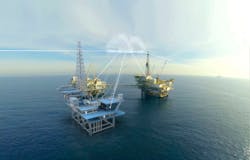Offshore staff
OSLO, Norway – DNV GL has made an international call to oil and gas operators and the supply chain to support a new methodology for digital twins.
The initiative will set out to determine whether data generated by digital twins is reliable, and assess whether the technology is delivering value.
Companies manufacturing oil and gas equipment must demonstrate its safety, quality, and integrity through recognized quality assurance principles.
However, there is no standard process exists that provides the same reassurance for digital representation of a physical asset and its behavior.
DNV GL says the methodology it is developing and testing for qualification of digital twins will provide that assurance, ultimately leading to wider adoption of the technology in the oil and gas market.
Its initial partnership with TechnipFMC led to the pilot, and this is now being opened to the wider industry.
DNV GL estimates that the digital twin market will grow from $3.8 billion in 2019 to $35.8 billion by 2025.
“If more sophisticated digital twins are to be widely accepted and developed at scale by the oil and gas industry, they need to be supported by accurate, valuable, and trusted technology,” said Liv Hovem, CEO of DNV GL - Oil & Gas.
“Our work with TechnipFMC and other partners through this new pilot aims to provide the industry benchmark to qualifying that a digital twin will perform as intended,” she added.
The methodology will address the fact that many digital twins currently represent an asset’s initial form and therefore do not necessarily reflect developments as the asset matures.
04/24/2020
